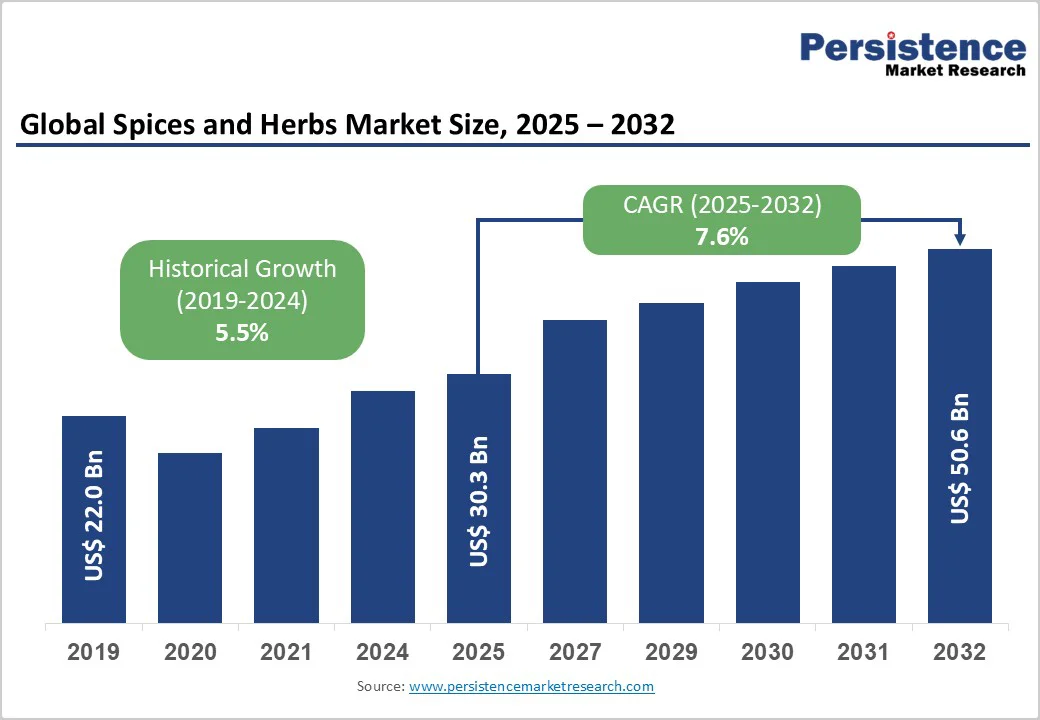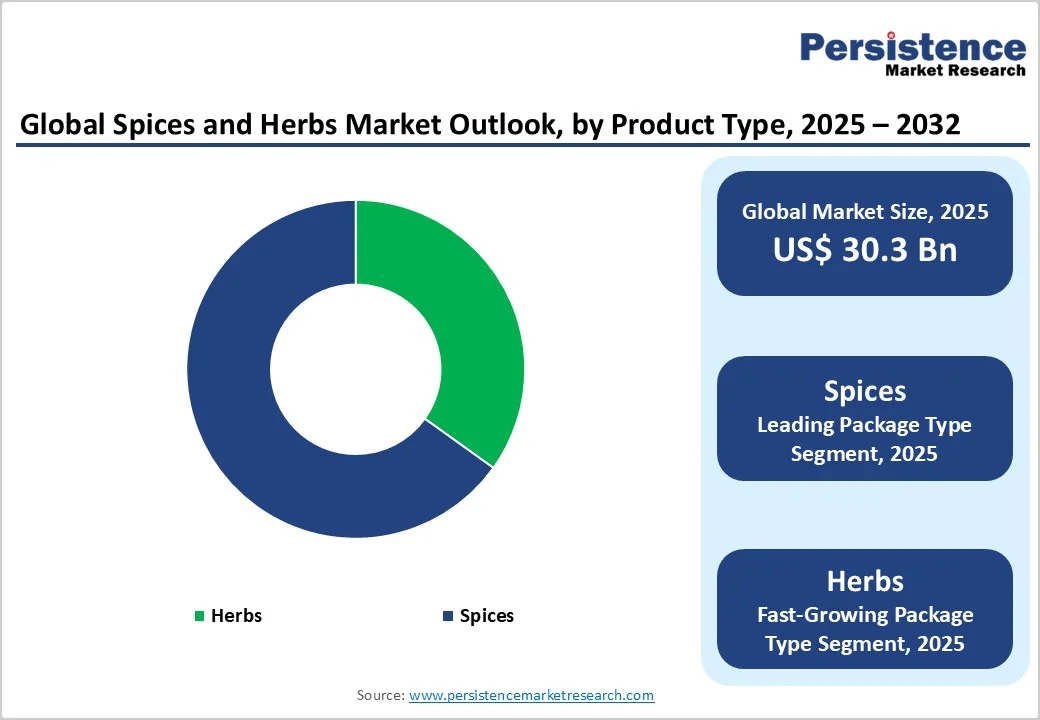ID: PMRREP31925| 155 Pages | 7 Nov 2025 | Format: PDF, Excel, PPT* | Food and Beverages

The global spices and herbs market size is likely to be valued at US$30.3 Billion in 2025 and is estimated to reach US$50.6 Billion in 2032, growing at a CAGR of 7.6% during the forecast period 2025 - 2032, driven by rising health consciousness, global culinary diversification, and expanding export demand.
| Key Insights | Details |
|---|---|
| Spices and Herbs Market Size (2025E) | US$30.3 Bn |
| Market Value Forecast (2032F) | US$50.6 Bn |
| Projected Growth (CAGR 2025 to 2032) | 7.6% |
| Historical Market Growth (CAGR 2019 to 2024) | 5.5% |

The rising appetite for global cuisines is spurring the demand for spices and herbs across both developed and emerging markets. As consumers experiment with diverse culinary styles, spices such as cumin, turmeric, paprika, and chili are becoming pantry essentials worldwide.
The surge in Asian, Middle Eastern, and Latin American restaurant chains across Europe and North America reflects this trend, with dishes including ramen, tacos, and curry, gaining mainstream acceptance.
Food manufacturers are also launching spice-based seasoning mixes and fusion sauces to cater to changing taste preferences. For instance, McCormick recently introduced global flavor blends inspired by Korean and Mexican cuisines. The widespread use of social media food content and international travel has further accelerated consumer curiosity toward authentic spice-rich flavors, making global cuisine trends a key growth catalyst for the market.
Consumers are increasingly drawn to spices for their proven health benefits rather than just taste improvement. Turmeric, ginger, and black pepper are widely used for their anti-inflammatory and immunity-boosting properties. Ayurvedic and wellness-focused brands such as Dabur and Organic India are incorporating spice-based formulations into teas, capsules, and supplements.
The global emphasis on natural ingredients and preventive health has also made functional spices a daily dietary staple. This health-oriented shift has encouraged farmers to produce high-curcumin turmeric and pesticide-free spice varieties to meet wellness-focused demand.
The rising occurrence of spice-related allergies and intolerances is emerging as a key restraint for market growth. Ingredients such as mustard, celery, and sesame have been identified as potential allergens in several regions, mainly in Europe and North America, where food safety authorities now mandate allergen labeling on packaged products.
According to the European Academy of Allergy and Clinical Immunology, reported cases of spice allergies have increased significantly in recent years, especially among children and individuals with pollen sensitivities. This rising awareness has led consumers to become more cautious about using blended or processed spices with undeclared components.
Frequent contamination issues involving pesticides market, heavy metals, and ethylene oxide have raised serious safety concerns in the global spice trade. In 2024, India-based brands such as MDH and Everest faced export restrictions in markets such as Singapore and Hong Kong after traces of ethylene oxide were found in their products, prompting strict testing requirements worldwide.
These incidents have shaken buyer confidence and disrupted supply chains for exporters in developing countries. Inconsistent quality standards and weak traceability in origin markets make it difficult to ensure uniform compliance with international food safety norms.
The surging use of blockchain and digital traceability systems is creating new export opportunities for India-based spice producers. These technologies help verify product authenticity, track sourcing, and ensure compliance with stringent global quality standards. The Spices Board of India’s initiative to introduce blockchain in turmeric and black pepper exports has already refined buyer confidence in European and Middle Eastern markets.
E-commerce platforms such as Amazon and Flipkart are also connecting small spice producers directly with global consumers, enabling entry into premium organic and specialty spice segments. This digital transformation is making India’s spice trade more transparent, efficient, and globally competitive.
Novel processing methods such as ohmic heating, radio frequency heating, and cold plasma treatment are opening new growth avenues for spice and herb producers. These techniques effectively eliminate pathogens while maintaining essential oils, color, and aroma.
Research collaborations between the Indian Institute of Spices Research (IISR) and food technology institutes are accelerating trials for such non-thermal sterilization methods. With global importers constantly rejecting chemically treated or overheated products, these clean and energy-efficient technologies can help India-based exporters meet strict food safety and sensory quality requirements, especially in Europe and North America.
Spices are speculated to capture nearly 65.1% of the share in 2025, as they serve multiple roles beyond flavoring. They improve aroma, color, and texture, and also act as natural preservatives.
In Asia Pacific, for example, spices such as turmeric, cumin, and clove are valued for their antibacterial and anti-inflammatory properties, making them integral to both culinary and medicinal practices. The increasing preference for natural and chemical-free ingredients in packaged food is another reason for their popularity.
Herbs are gaining popularity due to the rising trend of healthy and clean eating. Consumers are turning toward fresh and dried herbs such as basil, rosemary, mint, and parsley for their antioxidant and digestive benefits.
The natural wellness movement, which accelerated post-pandemic, has positioned herbs as functional ingredients rather than just garnishes. For example, Europe has seen a surge in herbal infusions and teas made from mint, chamomile, and lemongrass as consumers seek natural ways to improve immunity and relaxation.
Powder and granules are predicted to record about 41.2% of the share in 2025, as they provide longer shelf life, easy storage, and consistent flavor dispersion in food applications. These forms are mainly favored by the food processing industry since they blend uniformly in sauces, soups, snacks, and seasoning mixes.
Manufacturers also prefer powders due to their compatibility with automated processing and packaging systems. For example, Nestlé and Unilever rely heavily on spice powders for their instant noodles and ready-to-cook products, ensuring flavor uniformity across regions.
Spice and herb pastes are becoming increasingly important because they cater to the rising demand for convenience and ready-to-cook options. These pastes provide the authentic flavor of freshly ground spices while saving time for consumers and chefs.
In Southeast Asia, curry and chili pastes are staples in households and restaurants, while in Western countries, brands such as Patak’s and Thai Kitchen have made Indian and Thai pastes mainstream. The paste form also locks in volatile oils and moisture, preserving the fresh aroma and taste that often get lost in powdered forms.
Food will likely hold approximately 49.6% of the share in 2025, as spices and herbs are fundamental to culinary identity and product development. From bakery to meat processing, spices and herbs define flavor profiles, color, and shelf life.
Ready meals, snacks, sauces, and plant-based products all use a wide range of spices for differentiation and sensory appeal. For example, McDonald’s and KFC have developed region-specific recipes using local spices to appeal to diverse consumer palates.
Beverages are emerging as a key end-use segment as consumers increasingly seek functional drinks infused with natural ingredients. Spices and herbs such as ginger, cinnamon, cardamom, and mint are being used in teas, flavored waters, and energy drinks for their digestive, detoxifying, and anti-inflammatory benefits.
For instance, the rising popularity of turmeric lattes and cinnamon-infused coffees in North America and Europe emphasizes how beverages are becoming vehicles for functional wellness.

In 2025, Asia Pacific is expected to account for approximately 38.3% of the share, due to its superior culinary traditions and diverse agricultural base. India remains the world’s largest producer and exporter, followed by Vietnam, Indonesia, and China.
Asia Pacific is witnessing a steady shift toward premium and organic spices as urban consumers become more health-conscious. For instance, organic turmeric and ginger exports from India and Sri Lanka have risen sharply, pushed by global demand for natural ingredients in food and supplements.
Ready-to-use seasoning blends are gaining popularity among young consumers in urban centers such as Bangkok, Jakarta, and Mumbai, who prefer convenience without compromising on flavor. However, challenges such as unpredictable monsoons, rising logistics costs, and quality-control issues are compelling companies to invest in modern processing and traceability systems.
Europe is a mature and highly regulated market that prioritizes safety, sustainability, and transparency in the spice and herb trade. The region imports most of its spices from Asia Pacific and Africa, with the Netherlands, Germany, and the U.K. serving as leading entry points. Modern consumers now favor clean-label and ethically sourced products. For example, Fairtrade-certified pepper and organic basil have gained traction in supermarkets such as Lidl and Tesco.
Food manufacturers are also shifting from synthetic flavorings to natural herb extracts to meet EU clean-label guidelines. However, strict pesticide residue standards and traceability regulations make it difficult for small exporters from developing countries to maintain consistent access to the regional market. Climate change is also affecting herb cultivation in Mediterranean countries such as Spain and Greece, leading to high production costs and seasonal shortages.
North America’s market is characterized by a surging preference for bold flavors and functional spices linked to health benefits. The popularity of turmeric, cinnamon, and ginger continues to rise as consumers associate them with immunity and anti-inflammatory properties. The demand for authentic global flavors has increased due to the influence of multicultural cuisines, with U.S. consumers using Indian garam masala, Mexican chili blends, and Middle Eastern za’atar.
Brands such as Simply Organic and McCormick are extending their organic and non-GMO lines to cater to this demand. At the same time, small D2C players, including Burlap & Barrel, are gaining momentum for their single-origin, ethically sourced spices. However, the market faces challenges from fluctuating import prices and strict U.S. FDA regulations under the Food Safety Modernization Act, which requires detailed traceability and testing for imported spices.

The global spices and herbs market is highly competitive, with both multinational brands and regional players vying for a high share. Large companies such as McCormick & Company, Olam International, and Kerry Group dominate the global market through extensive supply chains, superior brand recognition, and investments in product development.
Regional firms such as Everest, MDH, and Catch in India, or Ducros in Europe, compete on affordability, local flavor authenticity, and wide distribution networks.
The spices and herbs market is projected to reach US$30.3 Billion in 2025.
Rising health awareness and surging demand for natural ingredients are the key market drivers.
The spices and herbs market is poised to witness a CAGR of 7.6% from 2025 to 2032.
The adoption of blockchain traceability and increasing preference for ready-to-use spice blends are the key market opportunities.
Givaudan S.A., Kerry Group Plc., and Ajinomoto Co., Inc. are a few key market players.
| Report Attribute | Details |
|---|---|
| Historical Data/Actuals | 2019 - 2024 |
| Forecast Period | 2025 - 2032 |
| Market Analysis | Value: US$ Bn |
| Geographical Coverage |
|
| Segmental Coverage |
|
| Competitive Analysis |
|
| Report Highlights |
|
By Product Type
By Form
By End-user
By Region
Delivery Timelines
For more information on this report and its delivery timelines please get in touch with our sales team.
About Author